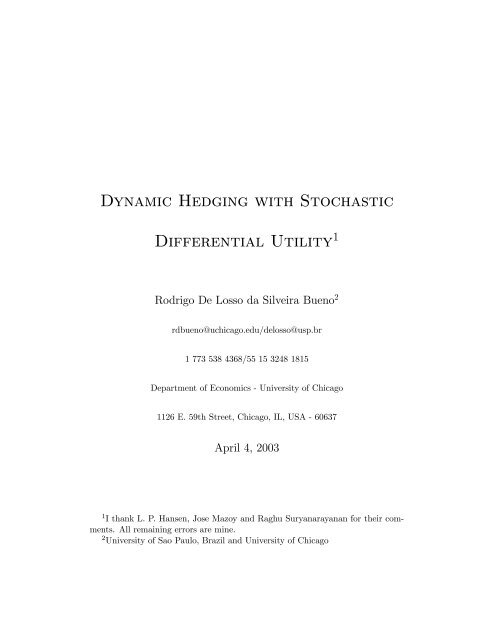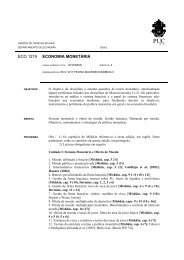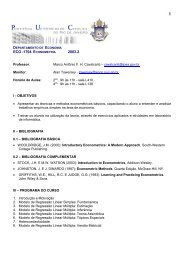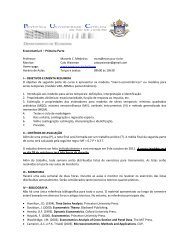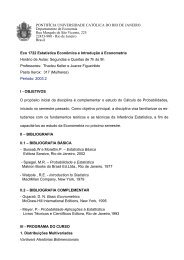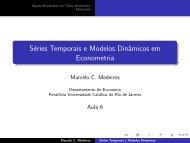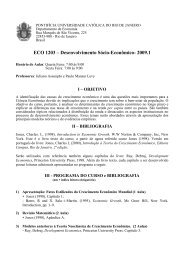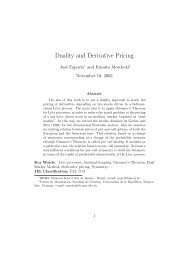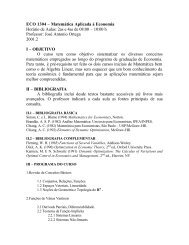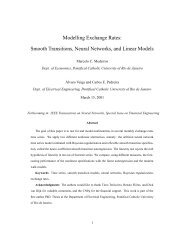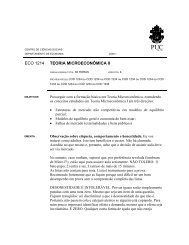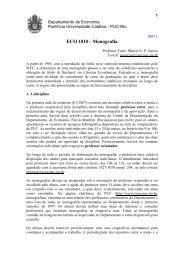Dynamic Hedging with Stochastic Differential Utility
Dynamic Hedging with Stochastic Differential Utility
Dynamic Hedging with Stochastic Differential Utility
Create successful ePaper yourself
Turn your PDF publications into a flip-book with our unique Google optimized e-Paper software.
<strong>Dynamic</strong> <strong>Hedging</strong> <strong>with</strong> <strong>Stochastic</strong><strong>Differential</strong> <strong>Utility</strong> 1Rodrigo De Losso da Silveira Bueno 2rdbueno@uchicago.edu/delosso@usp.br1 773 538 4368/55 15 3248 1815Department of Economics - University of Chicago1126 E. 59th Street, Chicago, IL, USA - 60637April 4, 20031 I thank L. P. Hansen, Jose Mazoy and Raghu Suryanarayanan for their comments.All remaining errors are mine.2 University of Sao Paulo, Brazil and University of Chicago
AbstractIn this paper we study the dynamic hedging problem using three differentutility specifications: stochastic differential utility, terminal wealth utility,and we propose a particular utility transformation connecting both previousapproaches. In all cases, we assume Markovian prices. <strong>Stochastic</strong> differentialutility, SDU, impacts the pure hedging demand ambiguously, but decreasesthe pure speculative demand, because risk aversion increases. We also showthat consumption decision is, in some sense, independent of hedging decision.With terminal wealth utility, we derive a general and compact hedging formula,which nests as special all cases studied in Duffie and Jackson (1990).We then show how to obtain their formulas. With the third approach wefind a compact formula for hedging, which makes the second-type utilityframework a particular case, and show that the pure hedging demand is notimpacted by this specification. In addition, <strong>with</strong> CRRA- and CARA-typeutilities, the risk aversion increases and, consequently the pure speculativedemand decreases. If futures price are martingales, then the transformationplaysnoroleindeterminingthehedgingallocation.Wealsoderivetherelevant Bellman equation for each case, using semigroup techniques.Keywords: <strong>Stochastic</strong> Control, Recursive <strong>Utility</strong>, <strong>Hedging</strong>, BellmanEquationJEL Classification: C61,D92,G11
1 INTRODUCTIONIn this paper we aim at studying the optimal futures hedging problem usinga continuous-time setting, stochastic differential utility (Duffie andEpstein,1992),SDU,andassumingMarkovianpricesasinAdlerandDetemple(1988). Then we extend the model in Duffie and Jackson (1990) - henceforthreferred to as DJ - in three ways. In the first, we maximize the intertemporalconsumption, in the spirit of Ho (1984). The consumption approachis interesting because in an intertemporal context, the agent is willing tostabilize the expected consumption stream. In order to perform such a task,the agent adjusts present consumption to account for investment for futureconsumption and holds positions in futures. The latter is called futures hedgingand the former consumption hedging. Recursive utility disentangles riskaversion from intertemporal substitutability, and therefore it may allow us toenhance the efficiency of the hedging strategy by means of its less restrictivestructure. Consequently, we think of this approach as a tool which hedgersmay use in order to improve the performance of their futures position, insuch a way that SDU adds some degrees of freedom in a possible empiricaltreatment still to be undertaken. However, <strong>with</strong> standard SDU, the formulathat we obtain depends upon the derivatives of the value function, which isnot easy to figure out. Thereby, to solve the optimal hedge, we potentiallyhave to employ numerical methods.Afterwards, in the second case, the agent maximizes the terminal wealth,a usual assumption when we are only worried about a specific futuredate.Maximizing the utility of the terminal wealth has an advantage of producingclosed formulas for some cases that arise naturally, and, hence, our analysis1
may be deepened further. As a matter of fact, we are able to produce ageneral hedging formula, which nests as special all cases studied in DJ’spaper. Then we specialize it to compare <strong>with</strong> those obtained by them.As a consequence of regarding prices as Markov processes, the myopichedging problem at each time 1 no longer holds necessarily. Hence, our optimalfutures hedging formulas are not the same as the corresponding statichedges, nor directly comparable to analogous solutions in discrete-time cases,as the results in Anderson and Danthine (1981, 1983).We would like to find some link between both approaches that we havementioned. We do this by making a suitable transformation on the TerminalValue-type utility. Then we take advantage of the compact formulas thatit produces and see explicitly what effect the SDU specification exerts onthe standard model, that is, we introduce the certainty equivalent machineryin the Hamilton-Jacobi-Bellman equation, HJB, of the terminal value utilityand study what effects this causes on the optimal hedge ratio. The particularconcave transformation that we employ is the connection between SDU andTerminal <strong>Utility</strong>. This adds some degrees of freedom and may potentially improvethe hedging strategy. The main advantage of this specification, hence,is to make DJ’s model a special case, and to allow us to derive interestingand neat results.Our model is similar to DJ in several aspects: spot and futures pricesare vector diffusion processes; a hedge is a vector stochastic process whichspecifies a futures position in each futures market; and the hedging profits1 Myopic hedging at each time means that an agent is hedging only local changes inwealth. Further discussion can be found in Adler and Detemple (1988) and the referencestherein.2
and losses are marked to market in an interest-paying margin account. Theoptimal hedge ratio will be obtained by maximizing the expected utility,composed by a committed portfolio of spot markets and the accumulatedvalue of the margin account.We reserve the appendix to derive the relevant HJB equations, takingadvantage of the semigroup approach.The paper is organized as follows: in Section 2, we present the primitivesof our model; in Section 3, we derive the optimal hedge under SDU; in Section4, we derive the optimal hedge ratio maximizing only the terminal utility andmake some specializations to compare our results <strong>with</strong> some of those obtainedby DJ and also previously in the paper; in Section 5, we derive the optimalhedge ratio under the proposed utility transformation and compare <strong>with</strong> ourprevious results; then, in Section 6, we conclude. In the appendix, we discusshow to obtain the relevant HJB equations; we provide some explanationsabout the differential utility, and also about some mathematical conceptsthatweusetoderivetheoptimalhedge.2 THE MODELAs mentioned earlier, our model is closely similar to DJ’s, because we consideran agent choosing a future trading strategy to maximize the expected utilityof consumption from t toafuturetimeT ∈ R + ∪∞, according to the followingsetup.1. Let B = ¡ B 1 ,B 2 ,... ,B N¢ 0denote a Standard Brownian Motion inR Nwhich is a martingale <strong>with</strong> respect to the agent’s filtered proba-3
ility space 2 . We also assume throughout the paper that probabilisticstatements are in the context of this filtered probability space.2. V denotes the space of predictable square-integrable processes 3 ,suchthat½·Z tV ≡ predictable υ :[0,T] × Ω → R ¯¯E0¸¾υ 2 sds < ∞,t∈ [0,T] ,where Ω is the state space, and predictable means measurable <strong>with</strong> respectto the σ-algebra generated by left-continuous processes adaptedto the agent’s filtration, that is, υ t depends only on information availableup to time t.3. There exist M assets to be hedged, whose value is described by anM-dimensional Markov process S, <strong>with</strong> the stochastic differential representationdS t = µ t (S t )dt + σ t (S t )dB t , (1)where µ is M-dimensional, σ is (M × N)-dimensional and µ m ∈ V andσ mn ∈ V for all m and n (hence, the Markov process S is well defined) 4 .4. There are K futures contracts available for trade at each instant of2 ” 0 ” indicates transpose, or differentiation when there is only one argument in thefunction.3 If T = ∞, then the square integrability condition changes to E £R ∞e βt υ 2 0 sds ¤ < ∞,where β is a constant characterized in Appendix C of Duffie and Epstein (1992).4 Henceforth, we omit the dependence of the parameters on S t for simplicity.4
time, whose prices are given by a K-dimensional Ito process F <strong>with</strong>the stochastic differential representationdF t = m t (F t )dt + υ t (F t )dB t , (2)where m k ∈ V and υ kn ∈ V for all k and n 5 .5. A futures position is taken by marking to market a margin accountaccordingtoaK-dimensional process θ = ¡ θ 1 , θ 2 ,... ,θ K¢ 0,<strong>with</strong>theproperty that θ 0 m as well as each element of θ 0 υ belong to V . Thespace Θ of all such futures position strategies is then described byΘ = {θ |θ 0 m ∈ V and θ 0 υ n ∈ V,∀n} .6. At time t the position θ t in the K contracts is credited <strong>with</strong> any gainsor losses incurred by futures price changes, and the credits (or debits)are added to the agent’s margin account. Thus, the margin account’scurrent value, denoted by Xt θ ,iscredited<strong>with</strong>interestattheconstantcontinuously compounding rate r ≥ 0. Furthermore, we assume thatlosses bringing the account to a negative level are covered by borrowingat the same interest rate, and ignore transactions costs and otherinstitutional features. In a continuous-time model, the margin accountthen has the formX θ t =Z t0e r(t−s) θ 0 sdF s , (3)5 Idem <strong>with</strong> respect to F t .5
indicating that the ’increment’ θ 0 sdF s to the margin account at times is re-invested at the rate r, implying a corresponding increment ofe r(t−s) θ 0 sdF s to the margin account by time t. Itsequivalentstochasticdifferential equation applying Ito’s Lemma isdX θ t = ¡ rX θ t + θ 0 tm t¢dt + θ0tυ t dB t . (4)7. Let π t ∈ R M be a bounded measurable function standing for the agentspot commitment. For simplicity, we also assume that the agent doesnot invest in any risky asset. Hence, the total wealth of the agent attime t, given a futures position strategy θ, isthenWt θ ,whereW θ is theItoprocesshavingthestochasticdifferential representationdW θt = π 0 tdS t + dX θ t − c t dt, (5)where c t ∈ V is the consumption rate at time t.8. Preferences of the agent over wealth at time t are given by the stochasticdifferential utility 6 U : V → R, whose ”aggregator”, (f,k), is definedas f : R D × R → R, and the variance multiplier, k, ask : R → R.We define f to be regular, meaning that f is continuous, Lipschitz inutility, and satisfies a growth condition in consumption 7 . In addition,we assume that f is increasing and concave in consumption 8 .Consider6 More details about SDU are given in the appendix B7 More details about the meaning of these concepts, see DJ and Duffie andEpstein(1992, p. 366).8 Then, we can apply freely Propositions 3 (monotonicity) and 5 (concavity) of Duffieand Epstein (1992).6
the von Newmann-Morgenstern index, h, which is continuous, strictlyincreasing, and satisfies a growth condition, implying it is integrable.It is called the risk-adjustment function and measures the local riskaversion. Because we also adopt assumption 2 in Duffie andEpstein(1992), we obtain k(J) = h00 (J)< 0. This leaves the problemh 0 (J)Z Tmax E t·f (c s ,J(z s )) + 1θ∈Θ,c∈Vs≥t2 k (J (z s)) Jz 0 sΣJ zs¸ds, (6)<strong>with</strong> δ > 0 being the subjective discount rate 9 .With this model in mind, we can define the optimal futures position.Definition 1 A futures position strategy θ is definedtobeoptimalifitsolves6.3 STOCHASTIC DIFFERENTIAL UTILITYIn this section we derive directly the optimal futures hedging, under Markovianprices and stochastic differential utility.Proposition 1 The optimal futures position strategy is θ SDU ,where(J ww + J wx )+k(J)(Jw 2 + J w J x )t = −(J ww +2J wx + J xx )+k(J)(Jw 2 +2J w J x + Jx) × 2θ SDU(υ t υ 0 t) −1 ·υ t σ 0 tπ t +J w + J x(J ww + J wx )+k(J)(J 2 w + J w J x ) m t¸. (7)9 Without recursive utility, f (c s ,J(z s )) = u (c s ) − δJ (z s ), and k(J) =0.7
Proof. Let W θt define the wealth process that would obtain starting attime t and<strong>with</strong>futuresstrategyθ, translating time parameters back t timeunits to time 0, ordW θts = a t+s ds + b 0 t+sdB s ,where a t+s = rXs θt +π 0 tµ t+s +θ 0 t+sm t+s −c t+s ,andb t+s = σ 0 t+sπ t +υ 0 t+sθ t+s .Similarly, let X θt be the t-translate of the process X defined bydX θts = α t+s ds + β 0 t+sdB s ,where α t+s = rXs θt + θ 0 t+sm t+s ,andβ t+s = υ 0 t+sθ t+s .Define the value function J : R 2 → R byJ (z t )=Z Tmax E t·f (c s ,J(z s )) + 1θ∈Θ,c∈Vs≥t2 k (J (z s)) Jz 0 sΣJ zs¸ds,and let J b : R 2 → R be defined by J b (z t )=E t [U (c)], wherez =(w, x),³´Z θSDU t0 ≡ W θSDU t0 ,X θSDU t0 =(w, x), <strong>with</strong> the boundary condition as J b (z T )=0 10 .Notice that:dZ t = µ ztdt + Λ zt dB t ,where µ zt=(a t , α t ) 0 ,andΛ zt =(b t , β t ) 0 .The HJB equation <strong>with</strong> recursive utility is given by u(c t ) − δJ + A d J +10 In special situations, we may vary from the convention of having zero terminal utility(see Duffie and Epstein, 1992).8
1k(J) ¡ ¢J 0 2 z tΣJ zt =0,whereAd is the infinitesimal generator 11 .Then, using the HJB equation we get:δJ = sup {u(c t )+J w a t + J x α t +θ∈R k ,c∈V+ 1 2 tr £ J ww b t b 0 t +2J wx β t b 0 t + J xx β t β 0 t + k(J)ΣJ zt J 0 z t¤ ¾ .Two observations are in order here. First, this program can be split intotwo independent decisions:sup (u(c t ) − J w c t ) , andc∈V© ¡ ¢sup Jw rXθts + π 0 tµ t+s + θ 0 t+sm t+s + Jx α t +θ∈R k+ 1 2 tr £ J ww b t b 0 t +2J wx β t b 0 t + J xx β t β 0 t + k(J)ΣJ zt J 0 z t¤ ¾ .Second, notice that:a. b 0 tb t =(σ 0 tπ t + υ 0 tθ t ) 0 (σ 0 tπ t + υ 0 tθ t )=π 0 tσ t σ 0 tπ t +2π 0 tσ t υ 0 tθ t + θ 0 tυ t υ 0 tθ t ⇒∂b 0 t b t∂θ t=2υ t σ 0 tπ t +2υ t υ 0 tθ t ;b. b 0 tβ t =(σ 0 tπ + υ 0 tθ t ) 0 υ 0 tθ t = π 0 tσ t υ 0 tθ t + θ 0 tυ t υ 0 tθ t ⇒ ∂b0 t β t∂θ t= υ t σ 0 tπ t +2υ t υ 0 tθ t ;c. β 0 tβ t = θ 0 tυ t υ 0 tθ t ⇒ ∂β0 t β t∂θ t=2υ t υ 0 tθ t .11 See appendix for details.9
Then it follows from the first order conditions for θ that:0 = (J w + J x ) m t + ¡ J ww + k(J)J 2 w¢(υt σ 0 tπ t + υ t υ 0 tθ t )+(J wx + k(J)J x J w )(υ t σ 0 tπ t +2υ t υ 0 tθ t )+ ¡ J xx + k(J)J 2 x¢υt υ 0 tθ t .Collect terms, and the result follows.The characterization of the optimal strategy is in terms of the derivativesof the value function as in Breeden (1984), Ho (1984), and Adler and De-Temple (1988); thereby, potentially we may have to solve this equation bynumerical methods. We can see that the optimal consumption is determinedindependently of the hedging decisions. This is a result similar to Ho (1984).Observe that the drift of the spot prices does not affect explicitly the futuresoptimal hedging. It may affect through other channels, however, as for instance,the derivatives of the Bellman equation. The utility parameters, thevolatility parameters of the prices and the drift of the futures prices affectthe optimal strategy in an evident way. Of course, it is easy to notice thatif k(J) = 0, then we have optimal futures hedging formula for the standardadditive utility specification 12 .12 See also the hedging formula in Section 4. This happens because of the independencebetween consumption and hedging decision.10
Under our assumptions about the utility and the aggregator, at the optimal,the first multiplicative term is positive 13 :A t ≡⎛⎛ ⎞ ⎛ ⎞−−+z }| { z}|{ z }| {⎝J ww + J wx⎠ + k(J) ⎝J w 2 + J w J x⎠⎞⎝J ww +2J wx + J | {z xx⎠ + k(J) ⎝J }w 2 +2J w J x + J 2 ⎠x| {z }−+⎛⎞> 0.Given we do not know the functional form the value function, it is difficultto say if A is greater or less than that under standard utility. However, wecan say that its sign does not change under SDU.In addition, the term that multiplies m t is negative:−R −1t≡⎛+z }| {J w + J⎞ x⎛⎞⎝J ww + J | {z wx⎠ + k(J) ⎝J }w 2 + J|{z}w J x⎠| {z }−−+< 0.We interpret R as being an extended version of the risk aversion coefficientbecause it includes terms like J x and J wx . The numerator is a measure ofthe global concavity of the value function plus the term originated from theSDU approach; and the denominator stands for the global curvature of thevalue function 14 . If the value function becomes more concave, either because13 From the first order conditions 0 0.14 With Terminal <strong>Utility</strong>, as we will see later, this term becomes the standard coefficientof risk aversion − JwwJ w.11
of the wealth or because the margin account, R increases as in the standardcase. Furthermore, notice that the SDU utility adds a penalty through thepresence of the additional term in the numerator: If the curvature of thevalue function increases, both numerator and denominator increase, makingthe net effect unknown (in the standard case, risk aversion would decrease.)The sign of R does not change under SDU. In short, the global net effectis that the extended risk aversion increases because of the presence of thementioned term in the denominator. This is, of course, an implication fromProposition 6 (Comparative Risk Aversion) in Duffie and Epstein (1992).With this in mind, Duffie (1989) arguably calls the first term betweenbrackets in equation 7 as the pure hedge demand, andthesecondtermasthe pure speculative demand 15 . The term pure hedge demand comes from auniperiod model, where we want only to minimize risks, that is, we minimizethe variance of our position, <strong>with</strong>out preoccupations <strong>with</strong> the return. In thiscase, θ t =(υ t υ 0 t) −1 υ t σ 0 tπ t (see additional discussion in Section 4.1).Ifthespotcommitmentiszeroattimet, the hedger may still be willing tobuy futures through the pure speculative demand term. This also would be soif covariance between spot and futures prices were null - υ t is orthogonal to σ t-, meaning that futures contracts do not provide any protection against spotprice fluctuations 16 . Also, if the covariance between futures and spot pricesincreases in absolute value, one increases the position under hedge, since therole of protecting against undesirable fluctuation in prices increases.15 Adler and Detemple (1988) call them, respectively, as the Merton/Breeden informationallybased hedging component, and as the mean-variance component.16 Here we are not taking into account equilibrium concerns.12
Looking at the second part inside the brackets, the formula shows thatthemultiplicativetermofm t has increased <strong>with</strong> the extra term in the denominator,for the entire expression is negative as we have already shown.Thus, its absolute value decreases. Therefore the contribution of the purespeculative demand to the optimal hedge strategy decreases <strong>with</strong> recursiveutility. If m t = 0, however, the solution does not depend explicitly on thedrift of futures prices, but differently from DJ, it depends on the parametersof the recursive utility through k(J) and the other derivatives.4 TERMINAL WEALTHIn this section, we practically hold the same model as before. However, wemake a fundamental modification by maximizing the utility of the terminalwealth, instead of the consumption over time. As a consequence, we considerhere a finite time, T . We also make a simplifying assumption by consideringthespotcommitmentconstantovertime. Thismakesourmodelidenticalto DJ’s, except that our prices are Markovian. This assumption about theprices is not new; Adler and Detemple (1988) have assumed it in a modelconstructed to solve a similar problem. Formally, we have:1. The agent is committed to receiving the value at time T of a positionin these assets represented by a fixed portfolio π ∈ R M ,leavingtheterminal value π 0 S T . Hence, the total wealth of the agent at time T ,given a futures position strategy θ, isthenWT θ ,whereW θ is the Ito13
process having the stochastic differential representationdW θt = π 0 dS t + dX θ t . (8)2. Preferences of the agent over wealth at time T are given by von Newman-Morgenstern utility function U : R → R, which is monotonic, twicecontinuously differentiable, strictly concave, <strong>with</strong> U 0 and U 00 each satisfyinga (linear) growth condition. This leaves the problemmax E £ ¡ ¢¤t U WθT . (9)θ∈ΘOf course the optimal position now is the one that maximizes statement9. Then we can state the proposition:Proposition 2 The optimal futures position strategy, by maximizing the terminalutility, is θ TV , whereθ TVt·(J ww + J wx )= −(J ww +2J wx + J xx ) (υ tυ 0 t) −1 υ t σ 0 tπ t +J ¸w + J x(J ww + J wx ) m t(10)Proof. Theproofisthesameastheonepresentedinthelastsectionexcept that π t+s = π, c t+s =0, ∀ s, t ≥ 0, andwedefine the value functionJ : R 2 → R byJ (z t )=maxθ∈Θ E £ U ¡ W θtT −t¢¤.Since we are maximizing as expected utility at a future date T , the HJB14
equation of this case is a little bit different, and it is given by A d J =0 17 .In this case, we define the boundary condition as bJ (z T )=U(w).Notice that we are only worried about the local mean effect, becauseof our interest in the terminal value of the wealth at the maturity of thecontract. Also, observe the similarity of this expression <strong>with</strong> that obtainedunder SDU, had we assumed k(J) =0.The qualitative analysis we provided before regarding the formula underSDU holds here <strong>with</strong>out modification, thus we do not repeat it.The formula can be compacted further! In order to do that, let us stateanimportantresultofourmodel:Proposition 3 The net return of the variation in the final wealth given avariation in the initial wealth is equal to the variation in the final wealthgiven a variation in the initial margin account. Formally,{exp [r (T − t)] − 1}∂WθtT −t∂wProof. Itô’s lemma on equation 4 gives us:X θ t = X θ 0 +Z tDifferentiate X θ t <strong>with</strong> respect to X θ 0:0∂X θ t∂X θ 0θt∂W= T −t∂x .Z¡ ¢ trXθs + θ 0 sm s ds + θ 0 sυ s dB s .Z t∂Xsθ =1+r ds.0 ∂X0θ017 See appendix C or Krylov (1980) for a proof.15
Define y s ≡ ∂Xθ s. Then the expression is an ordinary differential equation,∂X0θwhose solution is given byy t = y 0 e rt ,y 0 =1.Hence∂X θ T −t∂X θ 0= e r(T −t) .By Itô’s lemma again on equation 8:Z T −tWT θt−t = W0 θt += W θt0 +0Z T −t0a t+s ds +π 0 µ t+s ds +Z T −t0Z T −t0b 0 t+sdB s == W0 θt + π 0 (S T −t − S 0 )+XT θt−t − X0 θt .¡σ0t+s π ¢0 dB s + X θtT −t − X θt0 =Consequently the result follows.Proposition 3 says that a positive variation in the initial wealth impliesa positive variation in the final wealth, and hence, in the value function, aswe will see soon. Similar argument can be stated <strong>with</strong> respect to the initialposition in the margin account. In the proof, notice that an increase in theinitial margin account amounts to a gross return growth in the final marginduring the period considered.This result does not rely on the utility assumptions, but only on thebudget constraint. Consequently this result holds whether we are at theoptimal point or not.16
Lemma 1 Given the assumptions about utility and wealth in this section,0 >=J w=J ww + k(J)Jw2 £0¡ ¡ ¢¢E t h U Wθt0¡ ¢¤T −t U WθtT −tE thh ¡ 00 U ¡ ¢¢ £W ¡ ¢¤T θt−t U0WT θt 2−t+ h ¡ 0 U ¡ W θtT −t¢¢ ¡ ¢ i.U00WT θt−tProof. See appendix D.Consequently the hedge ratio simplifies enormously.Proposition 9 Given our assumption on the budget constraint and utility,the optimal hedging ratio is given byθ TWSDUt = − exp [−r (T − t)] (υ t υ 0 t) −1 ·υ t σ 0 tπ +Proof. Apply the corollaries of Section 4.J wJ ww + k(J)J 2 wm t¸. (16)This formula shows that the pure hedging demand is not affected by theSDU, similarly to the case of terminal wealth. Of course, if k(J) =0,wereturn to the standard case. J ww + k(J)Jw 2 < 0isasexpected.Butsincewedo not know the sign of J ww , it is not obvious that the risk aversion increases.Moreover, if m t = 0, then there is no effect of SDU on the optimal hedgeratio and the analysis of DJ that the demand for futures is based uniquelyonthehedgetheyprovideholds.25
5.1 EXPONENTIAL RISK-ADJUSTMENT: CRRA ANDCARAIn this section, we give two simple examples for concreteness, where we specifyh (u) =−e −ρu ,<strong>with</strong>ρ > 0. In both, we show that the risk aversionincreases, causing a decreasing on the pure speculative demand.First, suppose that u(w) =−e −γw ,whereγ > 0. Then 23µ JwwR = − + k(J)J w =Jà w£ ¡exp −ρU − 2γWθt= γ1+ρ E tT −tE t£exp¡−ρU − γWθtT −t¢¤ !We may interpret R as the global risk aversion parameter, as we havedone in Section 3. From this expression, we can see clearly that, <strong>with</strong> certaintyequivalent, we will need numerical methods to find the optimal hedgeratio. Also, we may realize that the risk aversion parameter increases bythe proportion ρ E t[exp(−ρU−2γWT θt−t)]> 0. Consequently the pure speculativedemand decreases 24 . Moreover, if ρ = 0, we are back to theE t[exp(−ρU−γWT θt−t)]TerminalValue-type utility example, given in the last section.¢¤23 We suppress the TWSDU superscript of θ for simplicity.24 We are not considering equilibrium effects.26
Second, suppose u(w) = w1−γ , γ > 0. Then1−γµ JwwR = − + k(J)J w =J w¢ i −1−γE the ¡ −ρU WT θt−t= γE the −ρU ¡ W θtT −t¢ −γiThe risk aversion increases again, because E t⎛⎝1+ ρ E the ¡ ¢ i−ρU WT θt −2γ⎞−tγ E the ¡ ¢ i⎠ −ρU WT θt −1−γ.−the −ρU (W θtT −t) −1−γiE the −ρU (W θtT −t) −γi> E th( W θtT −t) −1−γiE th(WθtT −t) −γi(see appendix E for a proof), and also because of the additional term betweenparentheses. In particular, <strong>with</strong> log-utility, γ = 1, the risk aversion coefficientincreases by a proportion somewhat greater than ρ.5.2 EQUILIBRIUMJust to complete our analysis, we consider an economy <strong>with</strong> a finite numberof agents, I. Then, we obtain:θ TWSDUit= −e −r(T i−t) (υ t υ 0 t) −1 £ υ t σ 0 tπ it − R −1it m t¤,where −R −1it =J i wJ i ww+k i (J i )J i2 wMarket clearing, P Ii=1 θ it =0,impliesthat:.P Im t = υ t σ 0 i=1 ω itπ itt P Ii=1 ω . (17)itRit−1The same analysis of Section 4 applies, and we do not repeat here.27
Of course, replacing equation 17 into equation 7 gives:θ TWSDUjt= −e −r(T i−t) (υ t υ 0 t) −1 υ t σ 0 t6 CONCLUSIONS"π jt − R −1jtP Ii=1 ω itπ itP Ii=1 ω itRit−1In this paper we study the dynamic hedging problem using three differentutility specifications: stochastic differential utility, terminal wealth utility,and a proposed utility which links both approaches. In all cases, we assumeMarkovian prices, as in Adler and Determple (1988). As a consequence ofthis assumption, we escape from a myopic hedging problem at each time.Furthermore, depending on the specification of the utility function, we mustuse different Hamilton-Jacobi-Bellman, HJB, equations.<strong>Stochastic</strong> differential utility, SDU, where we maximize consumption overtime as in Ho (1984), impacts the pure hedging demand ambiguously, becauseSDU parameters add both in the denominator and the numerator of theoptimal ratio.#.We see that SDU decreasesthepurespeculativedemand,because risk aversion increases.We also show that consumption decisionis independent of the hedging decision in the sense that we can split theprogram into two independent programs, one for the consumption and theother for the optimal hedging. In this case, if the drift of futures prices iszero, there is no obvious impact on the optimal hedge.Inthesecond-typeutilitycase,wederive a general and compact hedgingformula, which nests all cases studied in Duffie and Jackson (1990). This formulamay include the following particular assumptions found in DJ: Gaussian28
prices, mean-variance utility, and log-normal prices. We specialize to obtaintheir formulas.With the appropriately modified Terminal <strong>Utility</strong>, we find a compact formulafor hedging, which makes the second-type utility approach a specialcase, and show that the pure hedging demand is not impacted by this specification.We also see that, <strong>with</strong> CRRA- and CARA-type utilities, the riskaversion increases and, consequently the pure speculative demand decreases.If futures price are martingales, then such modification plays no role in determiningthe hedging allocation, giving exactly the same strategy of theTerminal Value environment.In the appendix, we derive the relevant Bellman equation for each case,using semigroup techniques.Although this is mainly a theoretical work, we might suggest some empiricalapplications of our model. For instance, we can try to simulate thehedge ratio and compare <strong>with</strong> some benchmark, varying the parameters ofour model, provided some stationary assumptions are satisfied. Another exampleis if we can compare our model <strong>with</strong> alternative ones and try to inferits efficiency. In both cases, we could suggest the optimal hedging strategy tobe followed by the hedger, and perhaps to say something about its possibleresults. Indeed, we believe that hedgers might be interested in testing theefficiency of this structure.29
References[1] ADLER, Michael & DETEMPLE, Jerome B. On the Optimal Hedge ofa Nontraded Cash Position. The Journal of Finance, vol.43,n. o 1, p.p.143-153, 1988.[2] AIT-SAHALIA, Yacine, HANSEN, Lars P. & SCHEINKMAN, José A.Operator Methods for Continuous-Time Markov Models. Manuscript,University of Chicago, 2002.[3] ANDERSON, Ronald W. & DANTHINE, Jean-P. Cross-<strong>Hedging</strong>.Journal of Political Economy, vol.89,p.p. 1182-1196, 1981.[4] ANDERSON, Ronald W. & DANTHINE, Jean-P. The Time Patternof <strong>Hedging</strong> and the Volatility of Futures Prices. Review of EconomicStudies, vol.50,p.p. 249-266, 1983.[5] BREEDEN, D. Futures Markets and Commodity Options: <strong>Hedging</strong>and optimality in incomplete markets. Journal of Economic Theory,vol. 32, p.p. 275-300, 1984.[6] DUFFIE, Darrell. Futures Markets. Englewood Cliffs: Prentice Hall,1989.[7] DUFFIE, Darrell & EPSTEIN, Larry G. <strong>Stochastic</strong> <strong>Differential</strong> <strong>Utility</strong>.Econometrica, vol.60,n. o 2, p.p. 353-394, 1992.[8] DUFFIE, Darrell & JACKSON, Matthew O. Optimal <strong>Hedging</strong> andEquilibrium in a <strong>Dynamic</strong> Futures Market. Journal of Economics <strong>Dynamic</strong>sand Control, vol. 14, p.p. 21-33, 1990.30
[9] EPSTEIN, Larry G. & ZIN, Stanley E. Substitution, Risk Aversion,and the Temporal Behavior of Consumption and Asset Returns: A theoreticalframework. Econometrica, vol.57,n. o 4, p.p. 937-969, 1989.[10] ETHIER, Stwart N. & KURTZ, Thomas G. Markov Processes: Characterizationand convergence. New York: Wiley, 1986.[11] HANSEN, Lars P. & SCHEINKMAN, José A. Semigroup Pricing.Manuscript, University of Chicago, 2002.[12] HO, Thomas S. Y. Intertemporal Commodity Futures <strong>Hedging</strong> andProduction Decision. The Journal of Finance, vol. 39, n. o 2, p.p. 351-376, 1984.[13] KRYLOV, Nicolai V. Controlled Diffusion Processes. New York:Springer-Verlag, 1980.[14] OKSENDAL, Berndt. <strong>Stochastic</strong> <strong>Differential</strong> Equations, 4. th ed. NewYork: Springer-Verlag, 1995.AppendixA-Infinitesimal GeneratorsHere we present some technical concepts that we have used along thepaper. First we present the infinitesimal generator approach, following closelyAit-Sahalia, Hansen and Scheinkman (2002). The HJB equation is easier toderive using this approach. Then we present the stochastic differential utility,accordingtotheauthors already cited.31
Let (Ω, =,P) denote a probability space, Ξ a locally compact metric space<strong>with</strong> a countable basis E, aσ-field of Borelians in Ξ, I an interval of the realline, and for each t ∈ I, X t is a stochastic process such that X t :(Ω, =,P) →(Ξ,E) is a measurable function, where (Ξ,E) is the state space.Definition 2 Q :(Ξ,E) → [0, ∞] is a transition probability if Q (x, ·) isa probability measure in Ξ, andQ (·,B) is measurable, for each (x, B) ∈(Ξ × E) .Definition 3 A transition function is a family Q s,t , (s, t) ∈ I 2 ,s < t thatsatisfies for each s
operatorZT t φ (x) =E [φ (y t ) |x 0 = x] =φ (y) Q t (x, dy) .The Chapman-Kolmogorov equation guarantees that the linear operatorsT t satisfy T t+s = T t T t .With this in hand we can propose a parameterization for Markov processes.To do this, let (L, k·k) 25 be a Banach space.Definition 5 A one parameter family of linear operators in L, {T t : t ≥ 0}is called strongly continuous contraction semigroup ifa. T 0 = I;b. T t+s = T t T s for all s, t ≥ 0;c. limt→0T t φ = φ; andd. kT t k ≤ 1.In general, the semigroup of conditional expectations determine the finitedimensionaldistributions of the Markov process, as we can infer from Ethierand Kurtz (1986, Proposition 1.6 of chapter 4).Now we can define infinitesimal generators. A generator describes theinstantaneous evolution of a semigroup. Heuristically we could think of it asthe derivative of the operator T <strong>with</strong> respect to time, when it goes to zero.Definition 6 The infinitesimal generator of a semigroup T t on a Banach25 Notice that V is contained in this space.33
space L isthe(possiblyunbounded)linearoperatorA defined by:T t φ − φAφ = lim .t↓0 tThe domain D(A) isthesubspaceofL for which this limit exists.If T t is a strongly continuous contraction semigroup, we can reconstruct T tusing its infinitesimal generator A (see Ethier and Kurtz (1986), Proposition2.7 of Chapter 1). Thus the Markov process can be parameterized using A.The space C of continuous functions on a compact state space endowed<strong>with</strong> the sup-norm is a common domain for a semigroup. For instance, thegenerator A d of a multivariate diffusion process is an extension of the secondorderdifferential operator:A d φ (x) ≡ d dt E x [φ (X t )] |t=0+= µ · φ x + 1 2 tr [Σφ xx] ,wheredx t = µ (x t ) dt + Λ (x t ) dB t ,tr is the trace operator, andΛ (x t ) Λ 0 (x t )=Σ (x t ) .For a formal proof see, for instance, Oksendal (1995). For more details, seeAit-Sahalia, Hansen and Scheinkman (2002), and Hansen and Scheinkman34
(2002).The domain of this second order differential operator is restricted to thespace of twice continuously differentiable functions <strong>with</strong> compact support.Appendix B - <strong>Stochastic</strong> <strong>Differential</strong> <strong>Utility</strong>The stochastic differential utility formulation by Duffie and Epstein (1992)is a continuous-time analogue of the utility model that appears in Epsteinand Zin (1989). As it is known, the main advantage of this framework comparedto the standard one is that we can disentangle risk aversion fromintertemporal substitutability. We now present the main characteristics ofthis approach, based on Duffie and Epstein (1992).Define J(z t ) as the value function, where z is the state variable. Thestandard additive utility specification in which the utility at time t for aconsumption process c is defined byJ(z t )=E t·Zs≥t¸e −δ(s−t) u (c s ) ds ,t≥ 0,where E t denotes expectation given information available at time t, andδ is the discount rate.The more general utility functions are named recursive, exhibit intertemporalconsistency and admit the Hamilton-Jacobi-Bellman’s characterizationof optimality. The stochastic differential utility U : V → R is defined as followsby two primitive functions: f : R D × R → R and k : R → R, asalready35
stated. When well defined, the utility process, J, for a given consumptionprocess, c, is the unique Ito process J having a stochastic differential representationof the formdJ(z t )=·−f(c t ,J(z t )) − 1 2 k(J)J 0 z tΣJ zt¸dt + J 0 z tΛ (z t ) dB t ,where the subscript of J indicates derivative <strong>with</strong> respect to the argument.In this framework the pair (f,k) is called ”aggregator”, that determinesthe consumption process, c, such that the utility process, J, is the uniquesolution toJ(z t )=E t·Zs≥t½f [c s ,J(z s )] + 1 ¾ ¸2 k(J)J z 0 sΣJ zs ds ,t≥ 0.We think of J(z t ) as the continuation utility of c at time t, conditional oncurrent information; and k(J) as the variance multiplier, applying a penalty(or reward) as a multiple of the utility ”volatility” J 0 zΣJ z . In a discrete timesetting, we could say that at time t, the intertemporal utility J (·,t+1)fortheperiodaheadandbeyondisarandomvariable.Thusfirst the agentcomputes the certainty equivalent, m (∼ J (·,t+1)|= t ), of the conditionaldistribution ∼ J (·,t+1)|= t of J (·,t+ 1), given information = t at time t.Then (s)he combines the latter <strong>with</strong> c t via the aggregator. The function fencodes the intertemporal substitutability of consumption and other aspectsof ”certainty preferences”, also generating a collateral risk attitude underuncertainty. The certainty equivalent function, m, encodes the risk aversionin the sense described in Epstein and Zin (1989).36
In this paper, our expected-utility based specification is:m (∼ J) =h −1 (E t [h (J)]) ,where J is a real-valued integrable random variable, ∼ J denotes itsdistribution, and h has been already defined in Section 2.It easy to see that, if f (c, j) =u(c)−δj, <strong>with</strong>k(J) = 0, then we are backto the standard formulation.Appendix C - Hamilton-Jabobi-Bellman EquationIn this subsection we derive the relevant HJB equations for our problemsFirst, we state the Hille-Yosida Theorem:Theorem 1 Let T t be a strongly continuous contraction semigroup on L <strong>with</strong>generator A. Then(δI − A) −1 g =for all g ∈ L and δ > 0.Z ∞0e −δt T s gds,Proof. See Ethier and Kurtz (1986), Proposition 2.1 of chapter 1.Standard Additive <strong>Utility</strong>If we apply this theorem to a standard additive utility function, say, J(z t )=h R iE t s≥t e−δ(s−t) u (c s ) ds ,t ≥ 0, we obtain the following HJB (standard)equation:37
Proposition 10 Assume u ∈ L and δ > 0. Then the HJB equation is:u(c t ) − δJ + A d J =0,as:Proof. (You may apply the theorem as well) Define the value functionConsequently:J(z t )=E t·ZJ(z t+ε )=E t+ε·Zs≥ts≥t+εTake the conditional expectations at t:T ε J(z t )=E t·Z¸e −δ(s−t) u (c s ) ds ,t≥ 0.¸e −δ(s−t−ε) u (c s ) ds ,t+ ε ≥ 0.s≥t+εSubtract the first equation from the last one:T ε J (z t ) − J (z t )=E t·Zs≥t+ε¸e −δ(s−t−ε) u (c s ) ds .Ze −δ(s−t−ε) u (c s ) ds −s≥t¸e −δ(s−t) u (c s ) ds .Divide by ε and take the limit when ε ↓ 0:LHSlimε↓0 εT ε J (z t ) − J (z t )= lim= A d J.ε↓0 ε38
Now, let us analyze the RHS:RHS = E t·Z= E t·Zs≥t+εs≥t+ε¸ ·Z¸e −δ(s−t−ε) u (c s ) ds − E t e −δ(s−t) u (c s ) ds =s≥te ¡ −δ(s−t) e δε u (c s ) − u (c s ) ¢ Z t+ε¸ds − e −δ(s−t) u (c s ) ds .Divide by ε and take the limit when ε ↓ 0:RHSlimε↓0 εh RE ¡ t s≥t+ε e−δ(s−t) e δε u (c s ) − u (c s ) ¢ ds − R it+εe −δ(s−t) u (cts ) ds= lim=ε↓0 ε· Z= limE t δ e −δ(s−t) e δε u (c s ) ds − ¡ ¢¸ u (c t+ε ) − e −δε u (c t+ε ) − u (c t )=ε↓0s≥t+ε= δJ (z t ) − u (c t ) .tInthesecondline,wehaveusedtheL’Hôpital’s rule.Hence the result follows.Standard Recursive <strong>Utility</strong>The same proof may be applied <strong>with</strong> recursive utility,E tZs≥t·f (c s ,J(z s )) + 1 2 k (J (z s)) J 0 z sΣJ zs¸ds.Proposition 11 Assume f,k ∈ L and δ > 0. Then the HJB equation is:u(c t ) − δJ + A d J + 1 2 k(J)J 0 z tΣJ zt =0,Proof. The idea is the same as before. We just have to show what39
happens to:E tZs≥t+ε12 k (J) J z 0 1sΣJ zs ds − E tZs≥t 2 k (J) J z 0 sΣJ zs ds == −E tZ t+εt12 k (J) J 0 z sΣJ zs dsDivide by ε and take the limit when ε ↓ 0:R t+ε 1E t t− limk (J) J 2 z 0 sΣJ zs dsε↓0 ε= − 1 2 k (J) J 0 z tΣJ ztFor another derivation attack, we refer to Duffie and Epstein (1992). Foraheuristicproof:J(z t )=εu(c t )+e −δ² h −1 (T ² h (J)) .Consequently:·0 = limε↓0"= limε↓0¸u(c t )+ e−δ² h −1 (T ² h (J)) − J=²u(c t )+ −δe−δ² h −1 [T ² h (J)] + e −δ² A d h(J)h 0 (J)1= u(c t ) − δJ(z t )+ A dh(J)h 0 (J) .#=The proof follows now by the same lines as in Proposition 14.40
Degenerated Additive <strong>Utility</strong>We apply the same kind of proof as before.£ ¡ ¢¤Proposition 12 The relevant HJB equation, which maximizes J (z t )=E t U WθtTis given by:A d J =0.£ ¡ ¢¤Proof. This is trivial. Just notice that J (z t )=E t U WθtT ,implying£ ¡ ¢¤J (z t+ε )=E t+ε U Wθt+εT .ThusT ε J (z t ) − J (z t )=0.And the proof follows the LHS of the second Proposition in this section.The reader is referred to Krylov (1980, chapter 5) for another derivationstrategy.Modified Degenerated Aditive <strong>Utility</strong>Here we can apply either of two equivalent specifications.41
Proposition 13 Suppose we want to define the following value functionZ£ ¡ ¢¤J (z t )=E t U Wθt 1 TT +2 E t k (J (z s )) Jz 0 sΣJ zs ds,s≥t<strong>with</strong> boundary condition J(z T )=U (w).Then, the relevant HJB equation isA d J + 1 2 k(J)J 0 z tΣJ zt =0.Proof. See earlier proofs.We could alternatively specify the following:Proposition 14 Suppose we want to define the following value functionJ (z t )=h ¡ £ ¡ ¡ ¢¢¤¢ −1 E t h U WθtT ,J(z T )=U (w).Then the relevant HJB equation is:A d J + 1 2 k(J)J 0 z tΣJ zt =0.Proof. Observe that:£ ¡ ¡ ¢¢¤h (J (z t )) = E t h U WθtT42
Now we follow the same procedure as before.£ ¡ ¡ ¢¢¤h (J (z t+ε )) = E t+ε h U Wθt+εT .Take the conditional expectations at t, andsubtractthefirst equation:T ε h (J(z t )) − h (J (z t )) = 0.Thus:LHSlimε↓0 εT ε h (J(z t )) − h (J (z t ))= lim= A d h (J(z t )) = 0ε↓0 εSince ∂h(J)∂z= h 0 (J)J z and ∂2 h(J)∂z∂z 0= h 00 (J)J z J 0 z + h 0 (J)J zz ,then0 = A dh (J)= 1 ·µ · ∂h + 1 µ ¸h 0 (J) h 0 (J) ∂z t 2 tr Σ ∂2 h (J)=∂z t ∂zt0= µ · J zt + 1 2 tr (ΣJ z tz t)+ h00 (J) £ ¤J02h 0 (J)ztΣJ zt == A d J + 1 2 k(J)J 0 z tΣJ zt ,Then it follows that:0= A dh (J)h 0 (J)= A d J (z t )+ 1 2 k(J)J 0 z tΣJ zt .43
Appendix D - Proof of Lemma 2Proof. Since J (z t )=h ¡ £ ¡ ¡ ¢¢¤¢ −1 E t h U WθtT ,thenh (J (zt )) = E £ h ¡ U ¡ WT −t¢¢¤ θt .Take the derivatives in both sides 26 :h 0 (J)J w = E·¡ ¡ ¢¢h 0 U Wθt0 ¡ ¢T −t U Wθt∂W θtT −tT −t∂w¸;h 0 (J)J x = E·¡ ¡ ¢¢h 0 U Wθt0 ¡ ¢T −t U Wθt∂W θtT −tWe provide only the second derivative for J wx :h 00 (J) J w J x + h 0 (J) J wx = ET −t∂x¸.·µh ¡ 00 U ¡ ¢¢ h ¡WT θt−t U 0 WθtT −t¢ i 2+h ¡ 0 U ¡ ¢¢W ¡ ¢¢T θt−t U00WT θt ∂WT θt−t−t∂wh ¡ 0 U ¡ ¢¢W ¡ T θt−t U0WT θt−tIf we apply Proposition 3, this simplifies to0
0 < J x = ¡ e r(T −t) − 1 ¢ E £ ¡ ¡ ¢¢h 0 U Wθt0¡ ¢¤T −t U WθtT −th 0 (J)= ¡ e r(T −t) − 1 ¢ J w ;=0 > h 00 (J) Jw 2 + h 0 (J) J ww =·= E h ¡ 00 U ¡ ¢¢ h ¡WT θt−t U 0 WθtE=⇒ J ww + k(J)Jw 2 =T −t¢ i 2+ h0 ¡ U ¡ W θtT −t¢¢ ¡ ¢¸U00WT θt−t =⇒hh ¡ 00 U ¡ ¢¢ £WT θt0¡ ¢¤ ¡−t U Wθt 2T −t + h0U ¡ ¢¢W ¡ ¢ iT θt−t U00WT θt−th 0 (J);0 > h 00 (J) Jx 2 + h 0 (J) J xx = ¡ e r(T −t) − 1 ¢ 2×·= E h ¡ 00 U ¡ ¢¢ h ¡ ¢ iWT θt−t U 0 2 ¡WθtT −t + h0U ¡ W θt=⇒ k(J)Jw 2 J xx+(e r(T −t) − 1) 2 = J ww + k(J)Jw 2 =⇒=⇒ J xx = ¡ e r(T −t) − 1 ¢ 2Jww ;T −t¢¢ ¡ ¢¸U00WT θt−t =⇒45
0 > h 00 (J) J w J x + h 0 (J) J wx = ¡ e r(T −t) − 1 ¢ ×·= E h ¡ 00 U ¡ ¢¢ h ¡ ¢ iWT θt−t U 0 2 ¡WθtT −t + h0U ¡ W θt=⇒ k (J) Jw 2 + h0 (J) J wx(e r(T −t) − 1) = J ww + k(J)Jw 2 =⇒=⇒ J xw = ¡ e r(T −t) − 1 ¢ J ww .T −t¢¢ ¡ ¢¸U00WT θt−t =⇒Appendix E - Risk Aversion Increases <strong>with</strong>Power <strong>Utility</strong>Proposition 15 With Power utility and exponential risk adjustment, riskaversion increases.Proof. Clearly cov(e −ρU , ¡ ¢ hWT θt −a−γ−t ),a=0, 1, is positive, since d exp −ρ W 1−γdW 1−γ0, and d W −a−γ < 0. Now, to simplify the notation, let q ≡ e −ρU , p ≡dW¡ ¢Wθt −1−γT −t ,andg ≡ ¡ WT −t¢ θt −γ. We want to prove thatSinceE (pq)E (gq) ≥ E (p)E (g) .i
And the same holds for E (gq) . Since each expectation is positive:E (g) E (pq) ≥ E (p) E (q) E (g);E (p) E (gq) ≥ E (p) E (q) E (g) .Subtract one from the other and the assertion is proved.47


